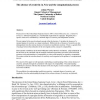Free Online Productivity Tools
i2Speak
i2Symbol
i2OCR
iTex2Img
iWeb2Print
iWeb2Shot
i2Type
iPdf2Split
iPdf2Merge
i2Bopomofo
i2Arabic
i2Style
i2Image
i2PDF
iLatex2Rtf
Sci2ools
148
Voted
JASIS
2010
2010
The absence of creativity in Feist and the computational process
The decision of the United States Supreme Court in 1991 in Feist Publications, Inc. v. Rural Tel. Service Co. affirmed originality as a constitutional requirement for copyright. Originality has a specific sense and is constituted by a minimal degree of creativity and independent creation. The not original is the more developed concept within the decision. It includes the absence of a minimal degree of creativity, as a major constituent. Different levels of absence of creativity are also distinguished, from the extreme absence of creativity to insufficient creativity. There is a gestalt effect of analogy between the delineation of the not original and the concept of computability. More specific correlations can be found within the extreme absence of creativity. `[S]o mechanical' in the decision can be correlated with an automatic mechanical procedure and clauses with a historical resonance with understandings of computability as what would naturally be regarded as computable. The ...
| Added | 19 May 2011 |
| Updated | 19 May 2011 |
| Type | Journal |
| Year | 2010 |
| Where | JASIS |
| Authors | Julian Warner |
Comments (0)

